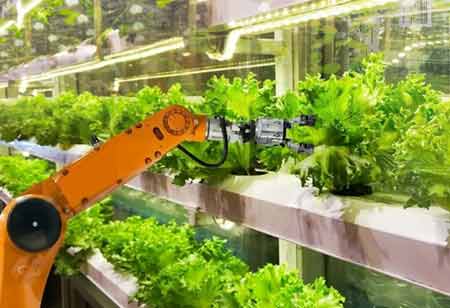Thank you for Subscribing to Agri Business Review Weekly Brief
Increased Crop Yields Through Vertical Farming
It appears as though modern farmers face numerous obstacles. Soil erosion and degradation,

By
Agri Business Review | Tuesday, April 28, 2020
Stay ahead of the industry with exclusive feature stories on the top companies, expert insights and the latest news delivered straight to your inbox. Subscribe today.
Vertical farming holds a great deal of potential and appears to be the way of the future farm. There are; however, a few roadblocks to consider before plunging headfirst into vertical farming.
FREMONT, CA: It appears as though modern farmers face numerous obstacles. Soil erosion and degradation, fluctuating weather patterns and climatic turmoil, the requirement for safe pest management and fertilization, and many other aspects must all be carefully examined. If one does not optimize his or her farming operation, he or she may risk losing an entire season's worth of effort. Even if he or she handles everything correctly, floods, fires, drought, or storms may cause him or her to lose. What is an agriculturist to do?
Farmers rely on innovative crop production methods and technologies to increase crop yields and protect themselves from losses. Vertical farming is a surefire way to boost production and mitigate risk. It has a plethora of advantages that all farmers should thoroughly investigate.
Using conventional farming methods, around 40 pounds of lettuce can be produced per 100 square feet of planting space using typical row plantings. On the other hand, vertical farming can produce almost three-quarters of a ton of leafy greens in the same amount of area.
Plants per Acre
Vertical farms enhance agricultural yields in the most obvious way by maximizing the production of each acre. Traditional field farms grow crops in long, low horizontal rows, necessitating large land. Vertical farming involves stacking plants vertically in trays or towers, enabling a farm to produce more food while maintaining a much smaller footprint.
A farmer may grow dozens of plants in the same space as one by stacking plants vertically. By optimizing space in this manner, it is possible to ensure higher yields.
Increased Annual Harvests
It is usual for traditional farms to have only one or two harvests per year. Due to the seasonal nature of crop growth, it is practically impossible to overcome this constraint. However, seasonal variations are unimportant because vertical farms are typically cultivated indoors.
Vertical greenhouses utilize a patented micro-climate technology. This technology enables our plants to receive the appropriate amount of heat, light, humidity, and other environmental factors for their specific demands. When farmers have complete control over the climate of their crops, they may bring them to maturity much faster and plant new ones as frequently as the cycle allows. Due to the short average harvest cycle of 28 days, growers can harvest 11-13 times every year. This represents a considerable increase in crop output.
Crop Loss Significantly Reduced
Avoiding crop loss is one of the most challenging issues in farming. Traditional farming methods make it challenging to protect against extreme weather, bug swarms, pollution and contamination, and concerns about soil erosion. Numerous factors conspire against farmers, and the majorities are beyond their control when plants are grown in an open-air environment.
Vertical farming also provides solutions to these issues. Climate problems are virtually nonexistent within the controlled atmosphere of a hydroponic greenhouse. This ensures that crop loss due to flooding or drought is unaffected. Indeed, vertical farms may thrive in places where inclement weather is the norm. These greenhouses continue to produce even in the driest deserts, the coldest tundra, and the most storm-prone areas.
Additionally, plants protected by the greenhouse system are significantly less prone to pest issues. While these cannot be avoided entirely, they are considerably more manageable in the absence of harmful chemicals.
On the other hand, Vertical farms frequently avoid soil-related concerns entirely through farming techniques that eliminate soil from the equation. Hydroponic farms are an ideal example, as they grow plants in water rather than soil. This eliminates erosion and soil degradation, allowing plants to absorb the optimal mix of nutrients directly to their roots.
With all these crop-killing concerns eliminated or significantly reduced, farmers may be confident that their plants will mature, harvest, and reach the market. Contrast that with traditional agricultural systems, which lose between 20 percent and 40 percent of crops each year to illnesses, animal pests, weeds, and much more to climate and weather catastrophes.





